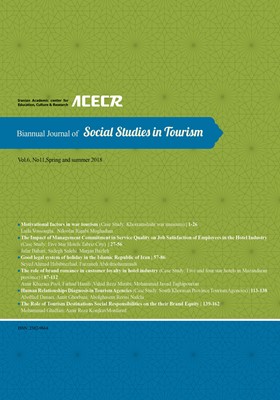عوامل انگیزشی در گردشگری جنگ مورد مطالعه: موزه جنگ خرمشهر
الموضوعات :لیلا وثوقی 1 , نیلوفر رحبی مقدم 2
1 -
2 -
الکلمات المفتاحية: گردشگری جنگ گردشگری تلخ انگیزه موزه جنگ خرمشهر,
ملخص المقالة :
در مطالعات اخیر گردشگری، انگیزه همواره از اهمیت زیادی برخوردار بوده است، زیرا رفتار گردشگر را توصیف می کند و در شناخت نحوه تصمیم گیری و انتخاب مقصد گردشگر مؤثر است. بررسیها نشان میدهد هر ساله گردشگران زیادی به مناطق جنگی سفر می کنند و در این مقصدها یادمان های مربوط به جنگ، بخش مهمي از جاذبههای گردشگری جنگ را تشکیل میدهند. در ایران نیز با توجه به آثار مربوط به جنگ تحمیلی هشت ساله، تقاضا و ظرفیت مطلوبی وجود دارد. هدف از پژوهش حاضر شناسایی عوامل مؤثر در ایجاد انگیزه گردشگران جنگ است و موزه جنگ خرمشهر، به عنوان مورد اين مطالعه انتخاب شده است. جامعه آماری این تحقیق را بازدیدکنندگان موزه جنگ تشکیل میدهند. دادههای لازم با استفاده از پرسش نامه و به روش نمونهگیری از270 بازدیدکننده، گردآوری شده است. در اين رابطه عوامل انگیزشی براساس 18 معیار مبتنی بر چهار مؤلفه ی تبلیغات، علاقه به کسب آگاهی و شناخت، وجود تسهیلات و امکانات و عوامل درونی مورد تجزیه و تحلیل قرار گرفتند. جهت تجزيه و تحليل داده ها از معادلات ساختاری استفاده شده است. براساس نتایج تحقیق، بیش ترین مقدار همبستگی گردشگری جنگ در موزه جنگ خرمشهر با شاخص علاقه به کسب آگاهی و شناخت (R2=0.645) بوده است.
حاجی نژاد، علی؛ جاودان، مجتبی؛ سبزی، برزو. (1392). «برنامه¬ریزی راهبردی توسعه گردشگری جنگ هم پیوند با سایرجاذبه¬ها در استان ایلام». فصلنامه علمی- پژوهشی مطالعات مدیریت گردشگری. سال 8، شماره 22. ص: 101-136.
خاطری، شهریار. (1389). گردشگري جنگ در جهان و درسهايي كه از آن براي ترويج فرهنگ صلح ميآموزيم. چاپ اول. تهران: نشر آفتاب گرافیک.
وثوقی، لیلا. (1388). گردشگری تلخ با تأکید بر گردشگری جنگ. فصلنامه مطالعات جهانگردی. شماره10، ص 127-105.
وثوقی، لیلا؛ خانی، فضیله. (1395). مروری بر رویکردها و مدل¬های برنامه¬ریزی توسعه گردشگری. چاپ اول. تهران: نشر مهکامه.
Alvarez, M. D., Go, F., & Yüksel, A. (2016). Heritage Tourism Destinations Preservation, Communication and Development. CABI.
Bigley ,J .Choon & et.al. (2010). Motivation for war-related Tourism: A Case of DMZ Visitors in Korea. Journal of Tourism Geographies, (12)3, 371-394.
Blom, T. (2000). Morbid Tourism – a Postmodern Market niche with an Example from Althorp. Norwegian Journal of Geograpghy, (54)1,29-36.
Ersoy ,G & Tuzunkan,D,. (2012). Dark Tourism in Galipoli: Forecast Analysis of Determine Potential of Australian Visitors. International Conference on Leadership-Technology and Innovation Management.
Farmaki, Anna. (2017). "The tourism and peace nexus," Tourism Management, 59, 528-540.
Gold, J.R., & Gold, M.M,. (2003). Representing Culloden-Social Memory ,Battlefield Heritage and Landscape of Regrets. Journal of Mapping Tourism, (34)1, 32-42.
Kang, A. (2012). Benefits of visiting a 'dark tourism' site: The case of the Jeju Peace Park Korea, Tourism Management, (33)4, 257-265.
Kostianen, Auvo. (2000). Battlefield Tourism: Pilgrimage & Commemoration of the Great War in Britain, Australia, and Canada-1919-1939, Annals of Tourism Research, (27)4, 1074-1076.
Krisjanous, Jayne. (2016). "An exploratory multimodal discourse analysis of dark tourism websites: Communicating issues around contested sites." Journal of Destination Marketing & Management, (5) 4, 341-350.
Lennon, John & Foley, Malcom. (2000). Dark Tourism: Attraction of Death and Disaster. Homson.
Lioyd ,D. (1998). Battlefield Tourism, Pilgrimage and the commemoration of the Great war in Britain, Australia and Canada ,1919-1939. Oxford: Berg.
Muzaini, Hamzah. (2008). Peace Education: Peace Museums. Encyclopedia of Violence, Peace and Conflict. Vol 2, Elsevier.
Niemelä, Titta. (2010). Motivation Factors in Dark Tourism Case: House of Terror. Lahti Uni of applied science. Bachelor’s thesis. The Faculty of Tourism and Hospitality.
Podoshen. Jeffry. (2013). Dark tourism motivations: Simulation, emotional contagion and topographic comparison. Tourism management, (35), 263-271.
Rojek, C. (1991). Ways of Escape, Bachelor’s thesis. University of Glascow.
Seaton, A. V. (1999). War and Thanatourism: Waterloo 1815- 1914, Annals of Tourism Research, (26) 1, 130-158.
Seaton, A. (1996). Guide by the dark: from thanatopsis to thanatourism, International Journal of Heritage Studies, (2) 4 ,234-244.
Sharpley, Richard. (2005). Travels to the edge of darkness: Towards a typology of dark tourism. Taking tourism to the limits: Issues, concepts and managerial perspectives (2005): 215-226.
Sharpley, Richard. (2009). Shedding light on dark tourism, The Darker Side of Travel: The Theory and Practice of Dark Tourism, Aspects of Tourism, Channel View Publications, Bristol, 3-22.
Šimková, E., & Holzner, J,. (2014) "Motivation of Tourism Participants", Procedia-Social and Behavioral Sciences. 159, 660-664.
Smith,V.L. (1998). War and Tourism: An American ethnography, Annals of Tourism Research, (25)1, 202-227.
Smith, V.L. (1996). War and its tourist attraction, in A.Pizam & Y.Mansfield (Eds)Tourist, Crime and International Security Issue ,247-264.
Stone, P. (2006). A dark tourism spectrum: Towards a typology of death and macabre related tourist sites, attractions and exhibitions, An Interdisciplinary International Journal, (54)2, 145-160.
Tunbridge, J., & Ashworth, G. (1996). Dissonant Heritage: Managing the past as a resource in conflict, Chichester: John Wiley.
Yuill,S. (2003). Dark Tourism: Understanding Visitor Motivation at Site of Death and Disaster, Thesis for the degree of MA, University of Texas.


